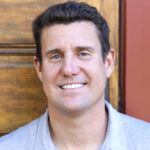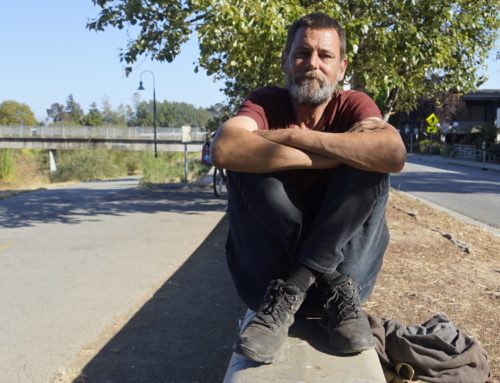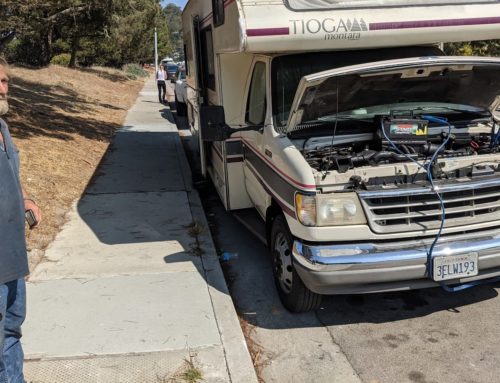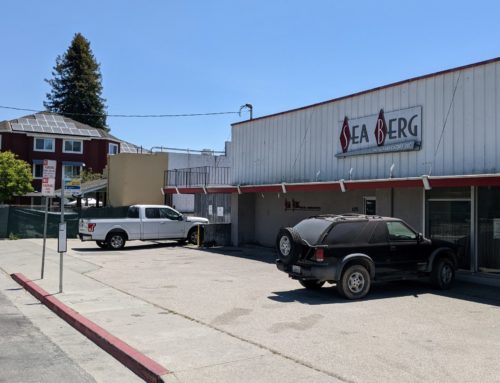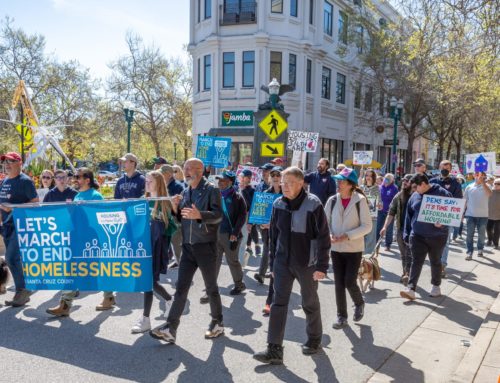Santa Cruz is one of dozens of cities across California that’s received a threat of a lawsuit if it doesn’t shift its city council to district elections. We break down the pros and cons of district elections. We talk with a state group that’s behind this push for district elections. We hear about the Santa Cruz City school board that just went through the process. And we look at some maps of how Santa Cruz has voted in the last two city council elections.
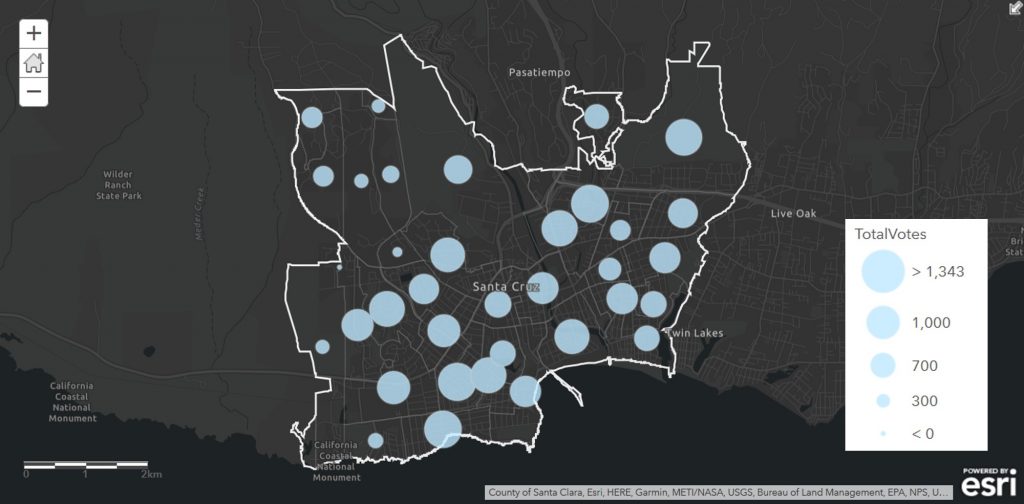
TRANSCRIPT
KARA MEYBERG GUZMAN: I’m Kara Meyberg Guzman and this is Santa Cruz Local.
Across the state, cities and counties are shifting to district elections of local leaders. And Santa Cruz City Council might be joining that pack.
So what are district elections? That’s when voters from a district elect their own representative for a city council. So, for Santa Cruz, it would mean dividing the city into six or seven districts and each district would elect its own councilmember.
Why does this matter? Advocates say district elections are more fair and representative. It lowers the barrier of entry and it’s more inclusive for Latino voters. Opponents in other cities say that they don’t need to switch to district elections because their system is already representative of Latino voters.
Today, we’ll talk about what district elections are and what they could mean for the City of Santa Cruz. We’ll talk with a state group that’s behind this push for district elections. We hear about the Santa Cruz City school board that just went through the process. And we hear about some maps of how Santa Cruz has voted in the last two city council elections.
OK. So let’s get into it. Stephen Baxter, Tell us about how city elections work now and what a change to district elections would look like.
STEPHEN BAXTER: The Santa Cruz City Council city council is seven members, Each council member represents the entire city. We don’t vote for all seven at once though, because council members’ terms end at different times.
So, the push up and down the state is to have district elections. District elections are where the city is split up into six or seven districts. Voters get to choose a city council member who represents just their district.
The idea is to lower the barrier of entry to get on the city council. That’s because a person would only have to campaign in their district to get elected. That way you’d have better representation of Latinos, for instance, who have not been represented much on the city council.
KMG: So why are we seeing this push toward district elections?
SB: Well it started with a threat of a lawsuit that the city of Santa Cruz received in July. It came from the Fargey Law Firm of Santa Barbara. And it was backed by the California Voting Rights Project.
Basically, the letter and the draft civil complaint that came with it said that the California Voting Rights Act of 2001 had been violated. And that the city of Santa Cruz has a system of elections that doesn’t adequately represent Latinos in this city.
Now this threat of lawsuit and draft complaint has been given to cities up and down the state.
According to census data, Latinos make up a little more than 20 percent of city residents. Yet since the year 2000, there have only been two Latinos on the city council. That’s Tony Madrigal, who was elected twice and David Terrazas, who was also elected twice.
You may be thinking, what about the African American representation on the city council? Right now we have a higher representation of African Americans on the city council than what our city demographics have. Doesn’t that mean that at-large elections can result in minority representation?
Well, the lawsuit focuses on Latinos. The lawyers argue that Latinos haven’t been represented on the city council in proportion to their demographics in the City of Santa Cruz.
I talked to Lanny Ebenstein. He’s the president of the California Voting Rights Project. He’s working with the Santa Barbara Law firm that’s pushing for district elections in Santa Cruz. Ebenstein is also from Santa Barbara. Santa Barbara started district elections in 2015.
LANNY EBENSTEIN: No question that the council has become more diverse ethnically. We now have two Latinos who are representing the districts that have larger percentages of Latinos. And our mayor is Latino as well. There haven’t been three Latinos on the Santa Barbara City Council since the 1800s.
KMG: Stephen, tell us more about the push we’re seeing across the state toward district elections.
SB: So, dozens of other cities have received these threats of lawsuit like the City of Santa Cruz has. Right now, about half of the elected bodies in the state have either gone to district elections or are moving toward them. There are more than 600 city councils, county boards of supervisors, school boards and other elected bodies in the state.
KMG: OK, so what are the advantages and disadvantages of district elections?
SB: According to Ebenstein and others advocates, one advantage would be that district residents would have someone to turn to specifically on the city council when they had problems. A second thing is that people who wanted to run for city council would have fewer barriers to entry. And that’s because they’d have a smaller area to canvas to get votes, as opposed to trying to knock on doors in the whole city, for instance. Third, you’d get more even representation geographically in the city. So other areas that haven’t had city council candidates now would have candidates.
For disadvantages of district elections, there could be more parochialism. As in, the council member feels only beholden to the district and could butt heads with other district that have different priorities.
Second, the district could have the potential to be gerrymandered so that some districts are “safe” where others are contested.
Another drawback to dealing with district elections is the cost of drawing district maps, hiring a demographer and paying the attorneys.
Either way, the city will have to pay. The city will either succumb to the threat of a lawsuit and move toward district elections. That would mean the city pays a maximum of $30,000 in legal fees. There’s a state cap.
Or, the city decides to fight the lawsuit, and it could pay much more than that in legal fees.
Santa Cruz Local’s mission is to produce fair and accurate local journalism that holds power to account. Show your support by becoming a member.
City Attorney Tony Condotti told me that the city has asked for more time to respond to the letter. It doesn’t have a formal position on it yet. And they have until Sept. 30 to respond.
One thing to consider is that no city has successfully litigated this and won.
The cities of Santa Monica and Poway, have challenged the lawsuit. Their case is going to go before the Ninth Circuit court of appeals sometime this year likely.
We should say that Santa Cruz City Schools just got done with switching to district elections. It received a similar letter from same law firm last year. The school board decided not to fight the lawsuit.
Rather, it hired a demographer to map out the school district. That cost approximately $30,000.
School district leaders reached out to their constituents to get input. They are expected to have their first district elections in November 2020.
DEBORAH TRACY-PROULX: My hope is that we’ll have better outcomes for kids. My hope is that people in the community will feel represented.
SB: That’s Deborah Tracy-Proulx. She’s the board president of Santa Cruz City Schools. I spoke to her this week.
TRACY-PROULX: The more people feel connected to their leaders, the more participation, especially parent participation, we have in schools, are really better outcomes for kids. Fingers are crossed that this will have a positive outcome and it will not have been a wasted effort.
KMG: Going back to Santa Cruz City Council. So for the council, this talk of district elections isn’t new. Tell us about the Charter Amendment Committee that was formed last year.
SB: Right. Even before the city council received this threat of lawsuit, it had already been looking into district elections. In summer 2018, the city council formed a 13-person committee to start looking at district elections and other related matters. The effort was spearheaded by then-Mayor David Terrazas.
TERRAZAS: I think with district elections, you have a defined area where each council member would be responsible for part of the city. Much like we’ve seen with the county board of supervisors, where you have five districts there, I think it provides a level of responsiveness and accountability to issues that are being faced within the city.
SB: But the committee’s work was put on hold in January of this year. Vice Mayor Justin Cummings said that the new city council might want a different purpose for the committee. Also, they were considering more members for it. So he asked the committee’s work be postponed. It hasn’t yet returned.
[MUSIC FADE IN]
KMG: There’s a perception in the community that UC Santa Cruz students have an outsized influence on elections. Some long-time residents feel that UCSC students vote once or twice and then they leave Santa Cruz. But it’s the long-time residents who are stuck with the outcome of the vote.
This is part of the reason why some people have been calling for district elections. Some people think it would limit the impact of UCSC students votes, if they’re largely contained largely in one district.
SB: But, it’s not that simple because about half of UCSC students live off-campus. So it’s hard to measure their impact.
What we can do though, is a thought experiment.
What if we looked at the vote tally from each voting precinct in the last two city council elections, and then, just ignored the votes from the campus precincts? Does the outcome of the election then change?
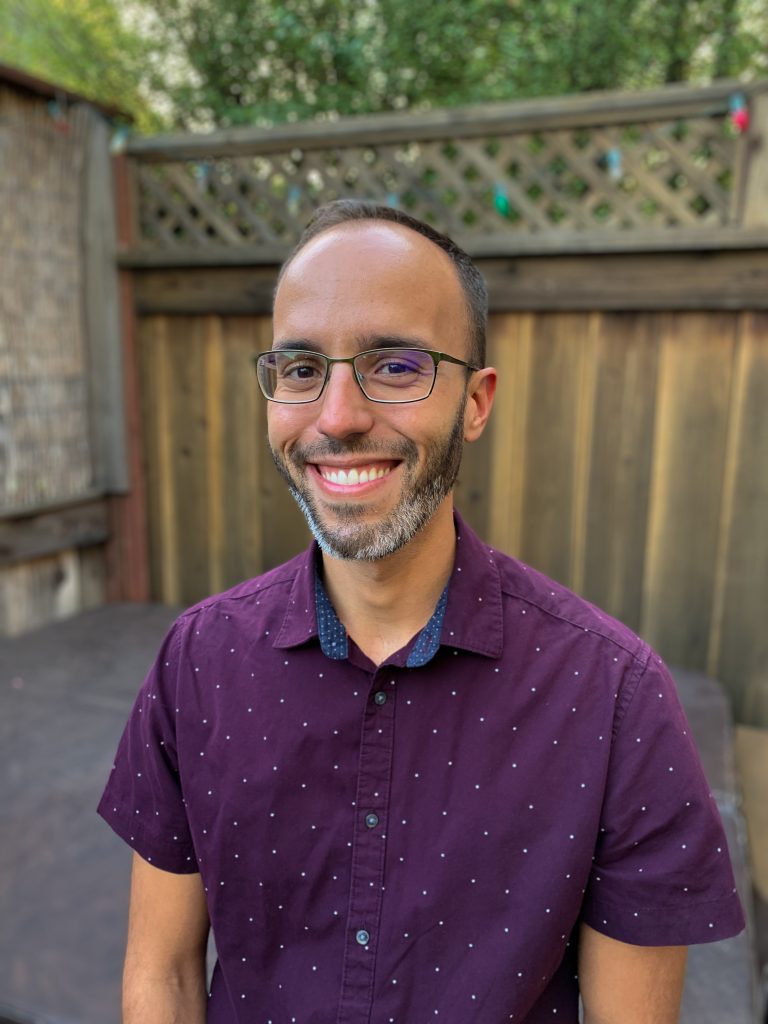
That’s exactly what Alex Nereson did. He makes maps for the county and visualizes complex data. Independent of his job at the county, he started looking into this. He’s a Santa Cruz resident interested in local politics.
NERESON: I was curious what influence UCSC has. Especially witht he recall petitions for Chris Krohn and Drew Glover, I feel like I’ve seen this claim in community forums often that UC Santa Cruz is somehow responsible for the election of these two city council members. And I wanted to see if there was any truth to that.
Map: 2016 Santa Cruz City Council Election Results
This map shows where the votes came from for the Santa Cruz City Council winning candidates in 2016. (Alex Nereson — Contributed)
How to play with this interactive map
- See a list of available layers: Click the icon in the upper-left corner of map.
- Toggle layers on and off: Click the icon in the upper left. Then check or uncheck the layer names.
- View symbol key for each layer: Click the icon in the upper left. Click on the layer name. Then click on the carrot symbol (>).
- View individual precinct results: Click on the voter precinct in map area.
SB: He found that Chris Krohn had strong support from the UCSC precincts. But Krohn also had support downtown and on the east side. He Krohn probably would have won without the UCSC campus vote.
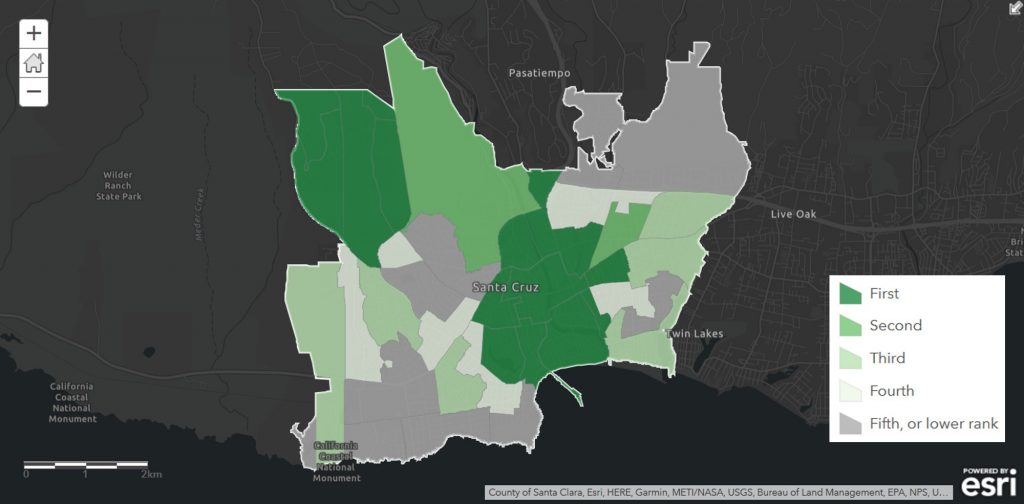
Another finding was that, if you subtract the campus precincts, in 2016, Sandy Brown would have fallen off the city council. Candidate Robert Singleton would have been on the city council.

In the 2018 election, Councilmember Drew Glover would have fallen off the city council. Greg Larson would have been on the city council.
Map: 2018 Santa Cruz City Council Election Results
This interactive map shows where the votes came from for the winning candidates in the 2018 Santa Cruz City Council election. For instructions on how to use this interactive map, see above. (Alex Nereson — Contributed)
KMG: So, what this shows is that UCSC, at least the campus vote, is a small but important part of how elections shake out in Santa Cruz. The UCSC campus vote accounts for about 8 percent of the total vote. And it does matter for some of the candidates. Certainly, there were candidates for whom it didn’t matter. So, for, like Martine Watkins, Chris Krohn, Donna Meyers, Justin Cummings. They had such a broad base of support that they would have won with or without the UCSC campus vote. But for candidates who didn’t garner as many votes, that UCSC campus vote really was key.
We’re really excited about Alex Nereson’s maps. They’re interactive. You can drill down on different layers and really nerd out.
So Stephen, tell us about Nereson’s map of where the city council members live.
SB: Right. We gave Nereson the addresses of the current city council. The map showed that the center of the city is where the current city council members come from. There are no city council members right now, who are from outlying areas, including Prospect Heights, Santa Cruz Gardens, and parts of the Eastside.
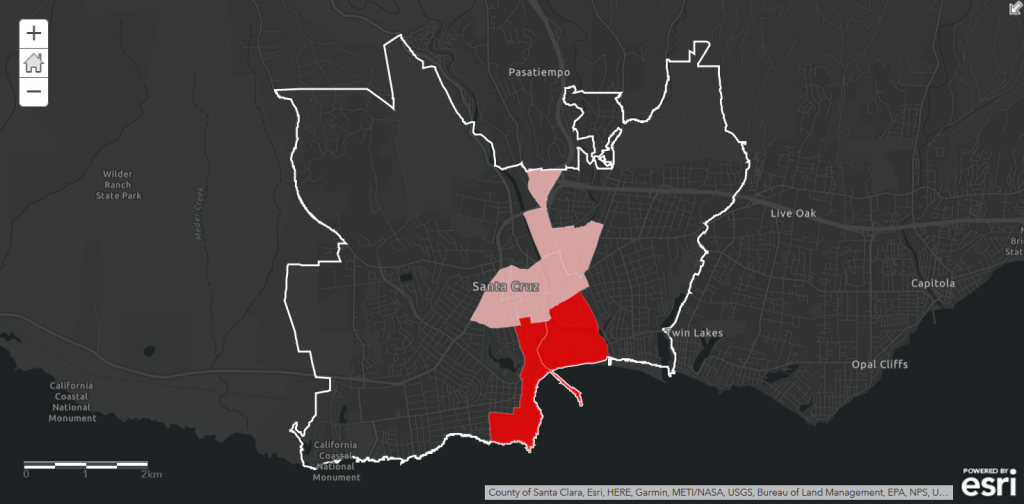
District elections would change that. You’d have to have a candidate from those outlying areas from each district.
KMG: What do you think district elections would mean for Latinos?
SB: We didn’t break down the way Latinos voted in our mapping project with Nereson. So it’s hard to draw any conclusions. But here’s what David Terrazas had to say. He was last the Latino city councilmember.
TERRAZAS: I don’t know whether or not there’s an actual California Voting Rights Act violation in terms of how our election system is set up here. I do know, though, there are tremendous barriers to access and serve in elected office. I do believe that Latinos and every other type of generation, age, race will have a greater opportunity on a neighborhood basis to run for office.
KMG: This story is going to keep developing as the city responds to the threat of lawsuit. We’ll find out more by Sept. 30. That’s the city’s deadline to respond.
One last thing, there’s an informational meeting about district elections tonight, Thursday Sept. 5 from 6 to 8 pm. It’s at Peace United Church of Christ at 900 High St. in Santa Cruz. Admission is free. It’s put on by the Santa Cruz County Business Council. Admission is free.
[MUSIC]
KMG: Before we go, a few announcements.
We wrapped up our first membership drive last night and we reached 137 members. Thank you all for your support.
Thank you also for helping us spread the word. We asked you to forward our emails and hand out flyers and post on Nextdoor and tell your friends, and it really helped.
Stephen and I know that our community needs this kind of reporting and your support shows us that you know it too. And we’re really grateful for that.
So our membership drive is over but all that means is that Stephen and I are going to return our focus to producing more episodes. But you can still sign up to be a member, if you haven’t already. Just visit santacruzlocal DOT org.
In the next few weeks Stephen and I will post another Meet Santa Cruz Local. We’ll update you on what’s next for Santa Cruz Local.
Lastly, a message for our members: Please join Stephen and me at our launch party. It’s Wednesday Sept. 18. It’s 5:45 to 7 p.m. at Cruzio in downtown Santa Cruz. There was an invite in your email newsletter this morning.
We’ll have snacks. We’ll have live music. We’ll have interactive activities. We want to thank you and celebrate with you. And we want to hear what’s important to you. Your feedback will help guide our reporting.
Speaking of thank yous.
Thank you to Santa Cruz Works for giving us the opportunity to speak at last night’s New Tech Meetup. If you’re a new listener who heard about us at that event, welcome.
Thank you to our guardian level members, Elizabeth and David Doolin, Chris Neklason and Patrick Reilly.
And special thanks to Alex Nereson, for sharing your maps and your expertise.
I’m Kara Meyberg Guzman. Thanks for listening to Santa Cruz Local.
Editor’s note: To see more maps of Santa Cruz City Council 2016 and 2018 election results, visit Alex Nereson’s StoryMaps page.
Stephen Baxter is a co-founder and editor of Santa Cruz Local. He covers Santa Cruz County government.
Kara Meyberg Guzman is the CEO and co-founder of Santa Cruz Local. Prior to Santa Cruz Local, she served as the Santa Cruz Sentinel’s managing editor. She has a biology degree from Stanford University and lives in Santa Cruz.

